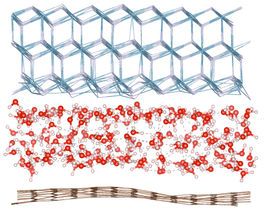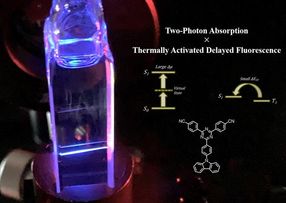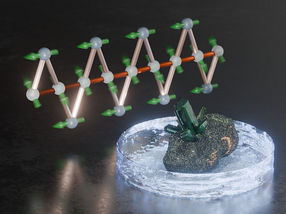Electric field provides stimulus: chemical system responds by forming liquid crystals
Jean-Marie Lehn, winner of the Nobel prize in chemistry (1987) and his co-worker Nicolas Giuseppone have now demonstrated that an electric field induces the preferred formation of liquid-crystalline imines.
They started with batches of amines (organic compounds with a nitrogen- and hydrogen-containing group, -NH2) and imines (molecules with an amine component whose nitrogen atom forms a bridge to a second organic component, -N=). The chosen amines and imines are able to react reversibly with each other such that added free amine 1 forces the amine component (amine 2) out of imine 1 to form the new imine 2. After a certain amount of time, an equilibrium is established between the forward and reverse reactions, so that a mixture of amine 1, amine 2, imine 1, and imine 2 is formed in which the relative concentrations of the components remains constant. The concentrations in such equilibrium mixtures are also dependent on external factors such as the temperature or pH of the solution. Any change disturbs the equilibrium, and the system responds by changing the relative concentrations.
Lehn and Giuseppone wanted to know if an electrical field could also serve as the stimulus to which such a system could respond. They thus selected their mixture of amines and imines so that one of the two imines is able to form a liquid-crystalline phase while the other is not. Liquid crystals are used for things like displays for electronic devices (LCDs). They are liquids whose molecules don't just float around in a disordered state; instead, they form many small regions with an ordered structure. In an electric field, these regions assemble themselves into a macroscopic structure.
How would the amine-imine mixture react to the application of an electric field? The field stabilizes the liquid-crystalline imine. This shifts the equilibrium to form more of the liquid-crystalline imine. Interestingly, as long as the field is applied, the liquid-crystalline phase demonstrates a kind of "self-cleaning" effect, in that it pushes out all molecules that are not involved in the formation of the liquid crystal.
These trials with liquid crystals are not an end in themselves; Lehn and his team are working out basic methods to use in search for molecules and structured materials that can fulfill very specific, narrowly defined functions. For example, a pharmaceutical agent that is meant to bind a specific enzyme must fit like a key in a lock. Instead of blindly searching for a needle in a haystack, the researchers use "dynamic combinatorial chemistry" to cause equilibrating mixtures of various molecular building blocks (dynamic libraries) to generate, preferentially among all possible combinations, the correct "key" that fits the lock. The present results indicate that an electrical field can also be a useful stimulus.
Most read news
Topics
Organizations
Other news from the department science

Get the chemical industry in your inbox
By submitting this form you agree that LUMITOS AG will send you the newsletter(s) selected above by email. Your data will not be passed on to third parties. Your data will be stored and processed in accordance with our data protection regulations. LUMITOS may contact you by email for the purpose of advertising or market and opinion surveys. You can revoke your consent at any time without giving reasons to LUMITOS AG, Ernst-Augustin-Str. 2, 12489 Berlin, Germany or by e-mail at revoke@lumitos.com with effect for the future. In addition, each email contains a link to unsubscribe from the corresponding newsletter.



























































